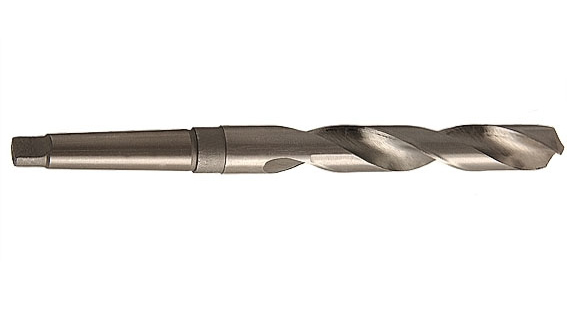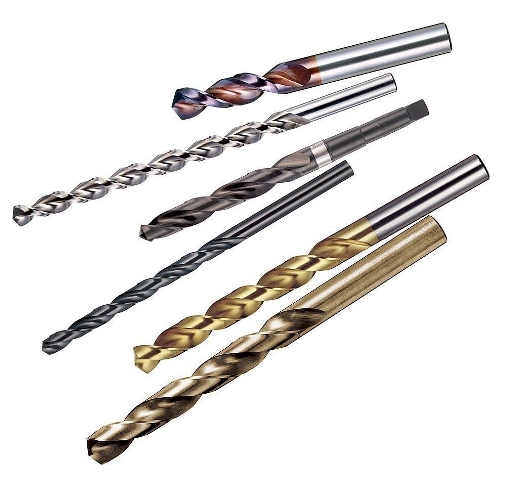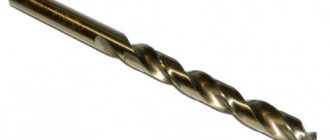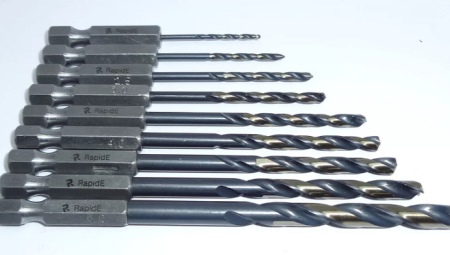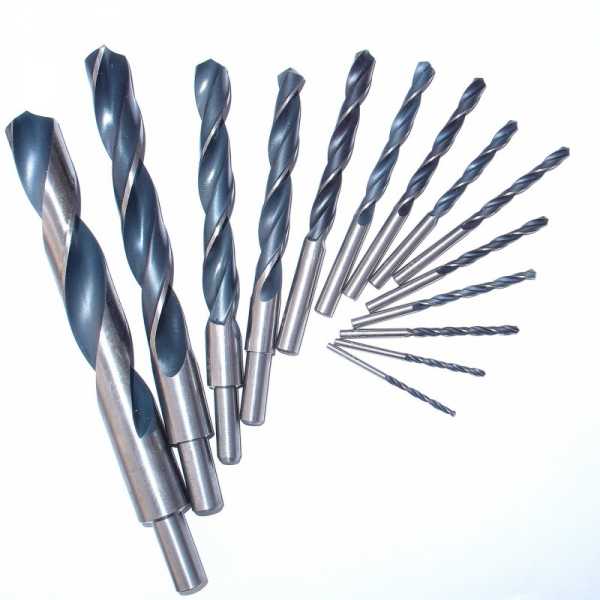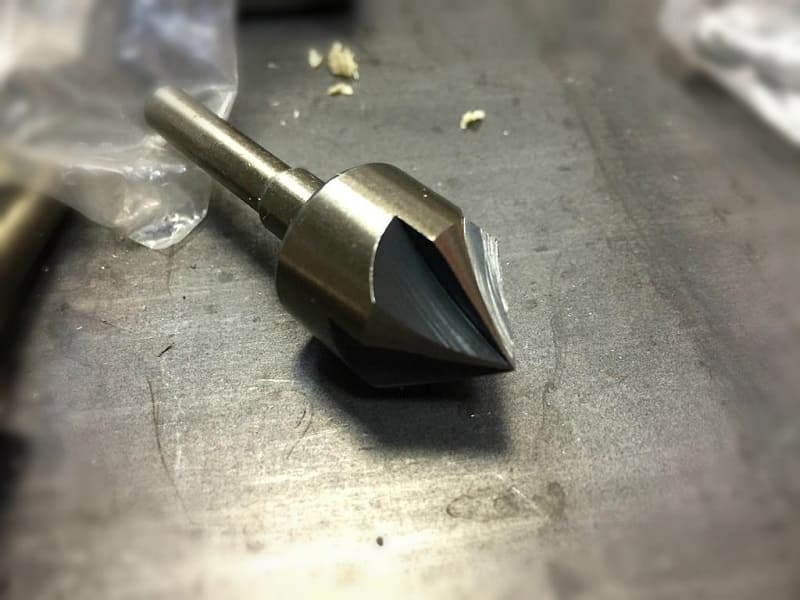Specifications
- Material of manufacture - used alloy and carbon steel 9XC, as well as P9 and P18. The latter belong to the category of high-speed steels and are designated as HSS. Such an alloy retains its hardness when heated, and, since drilling is accompanied by strong heating of both the material and the tool, the use of high-speed steel is quite justified.
- Sharpening angle - the magnitude of the angles of the main cutting edges and the transverse one determines the area of application of the drill. For plexiglass and other types of plastics, a tool with an apex angle of 60–90 degrees is required. An angle of 60 degrees is recommended when working with thin sheets, 90 degrees - when drilling material with a thickness of 20 mm or more.
A small sharpening angle improves heat dissipation, and since acrylic glass deforms when heated, this feature of the drill is very important for it. However, this sharpening affects the strength of the tool itself, and therefore is used only when working with non-solid materials.
- The clearance angle must be at least 15 degrees. With this sharpening, the rear surface of the drill scrapes the material, rather than cutting, which reduces the deformation of the plexiglass.
- Tip - in the usual case, it consists of two cutting edges with a convergence angle of 118-135 degrees. Drills are produced in which an additional chamfer is removed beyond the edges - double sharpening. This option reduces friction. Another enhancement is the two-stage tip for precise centering - this drill is designed for hard materials.
Diameter, length of the cone and cross-section of the shank are regulated by GOST 10903-77.
Varieties
The taper shank or Morse taper is available in several versions.
- Tool tools are the most common, as they are designed for quick automatic change when working on a machine. The parameters of the product are regulated by GOST.
- Shortened - the tail of the drill is reduced by the thickened part of the taper. It is marked as follows: B7 - shortened to 14 mm, B10 - to 18, and to B24 - shortened to 55 mm. This option is used when a hole requires a certain diameter but shallow depth.
- Elongated - used for drilling deep holes in several stages.
- Metric - shanks in which the ratio to the working part is 1:20, and the angle is more than 1 degree.
The photo shows the varieties of drills with a tapered tail
Also available are stepped drills and reinforced with plates.
Spiral conical
For drilling acrylic glass and other plastics, tool drills are used, as a rule, shortened, made of high speed steel. Plexiglas is a viscous material, prone to deformation when heated already at 160 degrees. Therefore, the use of a drill of the HSS class is preferable - high-speed steel has better heat dissipation.
The purpose of the drill is determined by the sharpening: apex angle, clearance angle, etc. Sharpening and grinding is carried out on special machines or manually.
The recommended drilling speed for plexiglas is 500–1000 rpm.
Conical GOST
GOST 10903-77 regulates a tool with a tapered shank - with a Morse taper, and a version with a neck.
- Possible product diameter - 5–10 mm.
- The length of the cone is 58–85 mm.
- The tail section is 6–12 mm.
Elongated
Drills with an extended tail section are regulated by GOST 2092-77. They are used in the production of deep holes.
The size of the diameter ranges from 6 to 30 mm. The length of the tail section is 145–275 mm.
Products are produced in two accuracy classes:
- A1 and A - with increased accuracy;
- B1 and B - with normal precision.
Conical stepped
The cone in this case looks like a pyramid, where each "step" is responsible for the formation of a hole of a certain diameter. This design allows you to drill holes of different sizes without changing tools. In its marking, a number of values are indicated at once.
The same feature allows you to chamfer with the same drill that made the hole. The drilling speed is relatively low - up to 1000 rpm, which makes the tool very suitable for working with plexiglass.
Centering is problem-free due to the tapered shape, but the sensitivity to misalignment is higher than that of the instrumental version.
They use tools for processing steel, aluminum, duralumin and non-metallic materials - plastics, plexiglass, ebonite.
Cobalt Taper Shank
To improve the strength properties and heat dissipation, the products are subjected to additional processing.
- HSS-G - undergo additional grinding;
- HSS-Co - steel contains cobalt, drills of this class are designed to work in severe temperature conditions;
- HSS-R - rolled products;
- HSS-Tin - the tool is treated with titanium nitride, the coating reduces friction, and, therefore, heating of the tool and material.
You can tell how the drills were treated by their color: a bright gold color indicates the deposition of titanium nitride, black - heat treatment was used, and so on.
Types
Taper shank drill bits are divided into four main groups.
- Shortened. They are needed in order to drill shallow holes. The shortening takes place in the wider part of the cone.
- Conical. They have a cone shape and are very easy to use.
- Metric. Shank and work area lengths are 1 in 20.
- Drills Morse. Differences from metric drills are minimal. There are special standard sizes for this type of gimbals, there are eight of them in total. With both metric and Morse bits, you can drill holes in a wide variety of materials: aluminum, cast iron, brass and bronze, all types of steels.
To make the Morse bit more durable, HSS steel is used for its manufacture. This enhances the cutter's ability to cut through steel and makes it easier to operate - even when drilling or reaming difficult holes. Taper shank products are ideal for drilling holes in surfaces of high strength and density materials. Thanks to the cone in the device, you can quickly change the attachment to another and align it precisely.

Taper shank drill options vary. They can have legs, and then the fastening will be carried out by fixing them in one position, then the drill will not rotate during operation. They can be threaded, and this is the most reliable option, because the stem, with the help of which the attachment is fixed, completely prevents the drill from falling out during operation. There are also products that lack both feet and threads. They work with materials such as plastic, ebonite, plexiglass, that is, relatively light.
Special drills are also available with holes or grooves for the coolant supply. But nozzles with a tapered shank are popular in everyday life, because they are easy to center, in addition, they are optimal for drilling holes with a large diameter, as they allow you to immediately set the desired parameters without additional drilling.
SPECIAL AND EXTENDED DRILLS WITH MK SHANKS
 View the catalog Morse taper drill bit DIN 341 View the catalog Morse taper drill bit DIN 341Reference: 242692 |
Drill bits for jig bushingsDIN 1870 (GOST 12121-77) Cutting material: HSS / HSS Co Coating: steam nitrided Point angle: 130 ° Spiral angle: 56 ° Tolerance: h8 Applications: For drilling in steel up to 1000 N / mm2, cast steel, cast iron, ductile iron, annealed iron, nickel and graphite. Features: Standard extra long drills designed to work through jig bushings only. |
| View the catalog Morse taper drill bit DIN 1870 series 1Reference: 242214 |
Long twist drills with Morse taper DIN 1870 series 1 Cutting material: HSS Coating: no Point angle: 118 ° Spiral angle: 56 ° Tolerance: h8 Applications: for drilling in steel up to 1000 N / mm2, cast steel, cast iron, nickel and graphite. Features: Standard drills for deep hole drilling, suitable for drilling without a center drill. Drilling deep holes requires coolant, short feed rates and frequent chip removal. |
 View the catalog Morse taper drill bit DIN 1870 Series 1 (TLS 1000C)Vendor code:242692 View the catalog Morse taper drill bit DIN 1870 Series 1 (TLS 1000C)Vendor code:242692
|
Long Morse taper drills DIN 1870 series 1 (TLS 1000C) Cutting material: HSS-Co Coating: nitriding Point angle: 130 ° Spiral angle: 30 ° Tolerance: h8 Application: intended for drilling deep holes in alloyed, bearing and hardened steels with hardness up to 1300 N / mm2. Features: Provides stable drilling without coolant, special flute profile provides excellent chip flow. The coating guarantees reduced tool wear and longer tool life. |
 View the catalog Morse taper drill bit DIN 1870 series 2Vendor code:242118 View the catalog Morse taper drill bit DIN 1870 series 2Vendor code:242118
|
Extra long Morse taper drills DIN 1870 series 2 Cutting material: HSS Coating: no Point angle: 118 ° Spiral angle: 56 ° Tolerance: h8 Applications: for drilling in steel up to 1000 N / mm2, cast steel, cast iron, nickel and graphite. Features: Standard drills for deep hole drilling, suitable for drilling without a center drill. Drilling deep holes requires coolant, short feed rates and frequent chip evacuation. |
| View the catalog Morse taper drill bit DIN 1870 Series 2 (TLS 1000C)Vendor code:242692 |
Extra long twist drills with Morse taper DIN 1870 series 2 (TLS 1000C) Cutting material: HSS-Co Coating: nitriding Point angle: 130 ° Spiral angle: 30 ° Tolerance: h8 Application: intended for drilling deep holes in alloyed, bearing and hardened steels with hardness up to 1300 N / mm2. Features: Provides stable drilling without coolant, special flute profile provides excellent return of long twisted chips. The coating guarantees reduced tool wear and longer tool life. |
7, 8. (Introduced additionally, Amendment No. 2).
APPLICATION
Reference
MAIN DIMENSIONS OF INTERMEDIATE DRILLS
The main dimensions of drills with intermediate diameters that differ from those specified in the standard must correspond to those indicated in the table.
mm
|
d |
L |
Morse taper |
||
|
over |
before |
|||
|
4,75 |
5,30 |
155 |
74 |
1 |
|
5,30 |
6,00 |
161 |
80 |
|
|
6,00 |
6,70 |
167 |
86 |
|
|
6,70 |
7,50 |
174 |
93 |
|
|
7,50 |
8,50 |
181 |
100 |
|
|
8,50 |
9,50 |
188 |
107 |
|
|
9,50 |
10,60 |
197 |
116 |
|
|
10,60 |
11,80 |
206 |
125 |
|
|
11,80 |
13,20 |
215 |
134 |
|
|
13,20 |
14,00 |
223 |
142 |
|
|
14,00 |
15,00 |
245 |
147 |
2 |
|
15,00 |
16,00 |
251 |
153 |
|
|
16,00 |
17,00 |
257 |
159 |
|
|
17,00 |
18,00 |
263 |
165 |
|
|
18,00 |
19,00 |
269 |
171 |
|
|
19,00 |
20,00 |
275 |
177 |
|
|
20,00 |
21,20 |
282 |
184 |
|
|
21,20 |
22,40 |
289 |
191 |
|
|
22,40 |
23,02 |
296 |
198 |
|
|
23,02 |
23,60 |
319 |
198 |
3 |
|
23,60 |
25,00 |
327 |
206 |
|
|
25,00 |
26,50 |
335 |
214 |
|
|
26,50 |
28,00 |
343 |
222 |
|
|
28,00 |
30,00 |
351 |
230 |
|
|
30,00 |
31,50 |
360 |
239 |
|
|
31,50 |
31,75 |
369 |
248 |
|
|
31,75 |
33,50 |
397 |
248 |
4 |
|
33,50 |
35,50 |
406 |
257 |
|
|
35,50 |
37,50 |
416 |
267 |
|
|
37,50 |
40,00 |
426 |
277 |
|
|
40,00 |
42,50 |
436 |
287 |
|
|
42,50 |
45,00 |
447 |
298 |
|
|
45,00 |
47,50 |
459 |
310 |
|
|
47,50 |
50,00 |
470 |
321 |
APPLICATION. (Introduced additionally, Amendment No. 2).
INFORMATION DATA
1. DEVELOPED AND INTRODUCED by the Ministry of Machine-Tool and Tool Industry of the USSR
2. APPROVED AND INTRODUCED INTO EFFECT by the Decree of the State Committee of Standards of the Council of Ministers of the USSR dated 14.10.77 No. 2443
3. The standard fully complies with ST SEV 6141-87
4. REPLACE GOST 12121-77
5. REFERENCE REGULATORY AND TECHNICAL DOCUMENTS
|
Designation of NTD referenced |
Item number |
|
GOST 2034-80 |
4 |
|
GOST 4010-77 |
6 |
|
GOST 25557-82 |
3 |
6. The limitation of the validity period was removed by the Resolution of the State Standard of 22.07.82 No. 2774
7. EDITION with Amendments No. 1, 2, approved in July 1982, October 1988 (IUS 11-82, 1-89), Amendment (IUS 11-2001)
Medium series. Design and dimensions
Taper-shank twist drills for hard to machine materials. Middle series. Construction and dimensions
GOST
20697-75
ISS 25.100.30
By the decree of the State Committee of Standards of the Council of Ministers of the USSR dated March 27, 1975 No. 783, the date of introduction was established
01.01.77
The limitation of validity was lifted by the Decree of the State Standard of the USSR of 27.08.82 No. 3417
1. This standard applies to HSS twist drills with a diameter of 6 to 20 mm, for drilling holes in difficult-to-cut materials.
2. Drills should be made of two types:
1 - with two guiding strips;
2 - with four guiding strips.
Each type of drills must be manufactured in the following accuracy classes:
A - increased accuracy;
B - normal accuracy.
3. The design and dimensions of the drills must correspond to those indicated in the drawing and in the table.

* For processing holes of grade 11.
Official edition ★
Reprinting prohibited
Edition with Amendment No. 1, approved in August 1982 (IUS12-82).
6-1-1323
Dimensions, mm
|
Type 1 |
Type 2 |
d |
NS nous Pestilence ze |
L |
To |
rf. |
TO |
a |
||||||||||
|
increased precision |
normal precision |
increased precision |
normal precision |
|||||||||||||||
|
Sign nie |
At change bridge |
Sign nie |
At change bridge |
Sign nie |
At change bridge |
Sign nie |
At change bridge |
Nominal. |
Prev off |
Nominal. |
Prev OFF |
|||||||
|
2302-0731 |
2302-0801 |
2302-0871 |
2302-0941 |
6,00 |
1 |
140 |
60 |
65 |
5,64 |
0,75 |
2,3 |
+0,18 0,10 |
0,25 |
-0,05 |
||||
|
2302-0732 |
2302-0802 |
2302-0872 |
2302-0942 |
6,20 |
145 |
65 |
70 |
5,83 |
2,5 |
0,30 |
||||||||
|
2302-0733 |
2302-0803 |
2302-0873 |
2302-0943 |
6,50 |
6,11 |
|||||||||||||
|
2302-0734 |
2302-0804 |
2302-0874 |
2302-0944 |
6.80 |
150 |
70 |
75 |
6.40 |
2,7 |
|||||||||
|
2302-0735 |
2302-0805 |
2302-0875 |
2302-0945 |
7,00 |
6,58 |
|||||||||||||
|
2302-0736 |
2302-0806 |
2302-0876 |
2302-0946 |
7.20 |
6.77 |
3,0 |
0,35 |
-0,06 |
||||||||||
|
2302-0737 |
2302-0807 |
2302-0877 |
2302-0947 |
7,50 |
7,05 |
|||||||||||||
|
2302-0738 |
2302-0808 |
2302-0878 |
2302-0948 |
7,80 |
155 |
75 |
80 |
7,33 |
3,2 |
|||||||||
|
2302-0739 |
2302-0809 |
2302-0879 |
2302-0949 |
8,00 |
7,52 |
|||||||||||||
|
2302-0741 |
2302-0811 |
2302-0881 |
2302-0951 |
8,20 |
7,71 |
3,4 |
0,40 |
|||||||||||
|
2302-0742 |
2302-0812 |
2302-0882 |
2302-0952 |
8,50 |
7.99 |
|||||||||||||
|
2302-0743 |
2302-0813 |
2302-0883 |
2302-0953 |
8,80 |
160 |
80 |
85 |
8,27 |
3,6 |
|||||||||
|
2302-0744 |
2302-0814 |
2302-0884 |
2302-0954 |
9,00 |
8,46 |
|||||||||||||
|
2302-0745 |
2302-0815 |
2302-0885 |
2302-0955 |
9,20 |
8,65 |
0,45 |
||||||||||||
|
2302-0746 |
2302-0816 |
2302-0886 |
2302-0956 |
9,50 |
8,93 |
|||||||||||||
|
2302-0747 |
2302-0817 |
2302-0887 |
2302-0957 |
9,80 |
170 |
90 |
95 |
9.22 |
3,8 |
|||||||||
|
2302-0748 |
2302-0818 |
2302-0888 |
2302-0958 |
10,00 |
9,40 |
|||||||||||||
|
2302-0749 |
2302-0819 |
2302-0889 |
2302-0959 |
10,20 |
40 B \ O |
1,00 |
4,1 |
0,50 |
||||||||||
|
2302-0751 |
2302-0821 |
2302-0891 |
2302-0961 |
10,50 |
9,90 |
|||||||||||||
|
2302-0752 |
2302-0822 |
2302-0892 |
2302-0962 |
10,80 |
175 |
95 |
100 |
10,20 |
||||||||||
|
2302-0753 |
2302-0823 |
2302-0893 |
2302-0963 |
11,00 |
10,30 |
|||||||||||||
|
2302-0754 |
2302-0824 |
2302-0894 |
2302-0964 |
11,20 |
10,50 |
4,5 |
||||||||||||
|
2302-0755 |
2302-0825 |
2302-0895 |
2302-0965 |
11,50 |
10,80 |
|||||||||||||
|
2302-0756 |
2302-0826 |
2302-0896 |
2302-0966 |
11,80 |
11,10 |
|||||||||||||
|
2302-0757 |
2302-0827 |
2302-0897 |
2302-0967 |
12,00 |
180 |
100 |
105 |
11.30 |
||||||||||
|
2302-0758 |
2302-0828 |
2302-0898 |
2302-0968 |
12,20 |
11,50 |
|||||||||||||
|
2302-0759 |
2302-0829 |
2302-0899 |
2302-0969 |
12,50 |
11,80 |
|||||||||||||
|
2302-0761 |
2302-0831 |
2302-0901 |
2302-0971 |
12,80 |
12,00 |
0,55 |
||||||||||||
|
2302-0762 |
2302-0832 |
2302-0902 |
2302-0972 |
13,00 |
12,30 |
4,8 |
+0,20 -0,10 |
|||||||||||
|
2302-0763 |
2302-0833 |
2302-0903 |
2302-0973 |
13,20 |
12,50 |
|||||||||||||
|
2302-0764 |
2302-0834 |
2302-0904 |
2302-0974 |
13,50 |
190 |
110 |
115 |
12,80 |
||||||||||
|
2302-0765 |
2302-0835 |
2302-0905 |
2302-0975 |
13,80 |
13,00 |
1 Why is the drill named conical?
Drills are cutting tools that create a hole by means of a translational-rotational action on the material at the point of contact. They are also often used for reaming or widening finished holes. In addition, they can be used to obtain blind recesses. Depending on the tail end, the drills are cylindrical, hexagonal, triangular and conical. If you look in the dictionary, then an instrumental taper means nothing more than a tapered shank, which means that this is a tapered drill. Its main convenience is a quick change: in the event of a breakdown, you can always easily and quickly. The shank itself is made in the form of a nozzle, which is put on the working part.
In terms of their design, conical drills do not differ much from conventional standard ones, and they consist of the following elements: cutting and guide parts, shank, driver and neck. The main difference is in the shank shape. In this case, it looks like a cone, which is what the name of these devices tells us about. Depending on its shape, they are divided into even more specific types. The shank can be of the following types:
- Morse taper;
- metric;
- instrumental;
- elongated.
You should devote a few minutes to a brief description of these types of nozzles, which we will do just below, and also consider other classifications.




